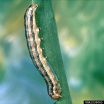(Press-News.org) Doctors tell us that the frenzied pace of the modern 24-hour lifestyle -- in which we struggle to juggle work commitments with the demands of family and daily life -- is damaging to our health. But while life in the slow lane may be better, will it be any longer? It will if you're a reptile.
A new study by Tel Aviv University researchers finds that reduced reproductive rates and a plant-rich diet increases the lifespan of reptiles. The research, published in the journal Global Ecology and Biogeography, was led by Prof. Shai Meiri, Dr. Inon Scharf, and doctoral student Anat Feldman of the Department of Zoology at TAU's Faculty of Life Sciences, in collaboration with Dr. Daniel Pincheira-Donoso of the University of Lincoln, UK, and other scientists from the US, the UK, Ecuador, and Malaysia.
The international team collected literature on 1,014 species of reptiles (including 672 lizards and 336 snakes), a representative sample of the approximately 10,000 known reptiles on the planet, and examined their life history parameters: body size, earliest age at first reproduction, body temperature, reproductive modes, litter or clutch size and frequency, geographic distribution, and diet. The researchers found that, among other factors, early sexual maturation and a higher frequency of laying eggs or giving birth were associated with shortened longevity.
Putting the Brakes on Physical Stress
"There were aspects of this study that we were able to anticipate," said Prof. Meiri. "Reproduction, for example, comes at the price of great stress to the mother. She experience physiological stress, is unable to forage efficiently, and is more vulnerable to her surroundings. This reflects evolutionary logic. To relate this to humans, imagine the physical stress the body of an Olympic gymnast experiences -- and the first thing that disappears is her period. In reptiles, it also increases the probability of being preyed upon.
"We found that reptiles that were sexually mature early on were less likely to make it to old age," Prof. Meiri continued. "Live fast and die young, they say -- but live slow, live long."
Eat Your Greens
The team also discovered that herbivores -- lizards with a plant-rich diet -- lived longer than similar-sized carnivores that ate mostly insects. Ingestion of a protein-rich diet seemed to lead to faster growth, earlier and more intense reproduction, and a shortened lifespan. Herbivorous reptiles were thought to consume nutritionally poorer food, so they reached maturity later -- and therefore lived longer.
Hunting may also be riskier than gathering fruits and leaves -- at least for animals, the researchers concluded. "If you're an animal, hunting your food can be dangerous," said Prof. Meiri. "You risk injury or even death. This is why you cannot simply transfer this logic to humans. Going to buy a head of lettuce at the supermarket is just as risky as going to the meat department. As a reptile, if you eat plants, you may need to be frugal, take life more slowly, and save your calories for digestion. You are forced to have a slower life, a more phlegmatic existence."
The researchers also found correlates that suggested reptiles in geographically colder regions lived longer - probably due to two factors: hibernation, which offers respite from predators, and slower movement due to a seasonal drop in metabolic rate. "Our main predictors of longevity were herbivorous diets, colder climates, larger body sizes, and infrequent and later reproduction," said Prof. Meiri. "I stress that you cannot simply transfer the results of a study on lizards to humans -- but this is the first study of its kind on reptiles, which does open up an avenue for further research on other factors that lead to longevity of these and other species."
INFORMATION:
American Friends of Tel Aviv University (http://www.aftau.org) supports Israel's most influential, most comprehensive and most sought-after center of higher learning, Tel Aviv University (TAU). US News & World Report's Best Global Universities Rankings rate TAU as #148 in the world, and the Times Higher Education World University Rankings rank TAU Israel's top university. It is one of a handful of elite international universities rated as the best producers of successful startups, and TAU alumni rank ninth in the world for the amount of American venture capital they attract.
A leader in the pan-disciplinary approach to education, TAU is internationally recognized for the scope and groundbreaking nature of its research and scholarship -- attracting world-class faculty and consistently producing cutting-edge work with profound implications for the future.
If you want to see into the future, you have to understand the past. An international consortium of researchers under the auspices of the University of Bonn has drilled deposits on the bed of Lake Van (Eastern Turkey) which provide unique insights into the last 600,000 years. The samples reveal that the climate has done its fair share of mischief-making in the past. Furthermore, there have been numerous earthquakes and volcanic eruptions. The results of the drilling project also provide a basis for assessing the risk of how dangerous natural hazards are for today's population. ...
WASHINGTON, D.C. - Two or more serious hits to the head within days of each other can interfere with the brain's ability to use sugar - its primary energy source - to repair cells damaged by the injuries, new research suggests.
The brain's ability to use energy is critical after an injury. In animal studies, Ohio State University scientists have shown that brain cells ramp up their energy use six days after a concussion to recover from the damage. If a second injury occurs before that surge of energy use starts, the brain loses its best chance to recover.
In mice, ...
Mikhail Kosiborod, M.D., of Saint Luke's Mid America Heart Institute, Kansas City, and colleagues evaluated the efficacy and safety of the drug zirconium cyclosilicate in patients with hyperkalemia (higher than normal potassium levels). The study appears in JAMA and is being released to coincide with its presentation at the American Heart Association's Scientific Sessions 2014.
Hyperkalemia is a common electrolyte disorder which can cause potentially life-threatening cardiac arrhythmias and is associated with chronic kidney disease, heart failure, and diabetes mellitus. ...
BLOOMINGTON, Ind. -- An Indiana University-Dartmouth College team has identified genes and regulatory patterns that allow some organisms to alter their body form in response to environmental change.
Understanding how an organism adopts a new function to thrive in a changing environment has implications for molecular evolution and many areas of science including climate change and medicine, especially in regeneration and wound healing.
The study, which appears in the journal Molecular Biology and Evolution, provides insight into phenotypic plasticity, a phenomenon that ...
November 17, 2014, PORTLAND, Ore. -- People who received automated reminders were more likely to refill their blood pressure and cholesterol medications, according to a study published today in a special issue of the American Journal of Managed Care.
The study, which included more than 21,000 Kaiser Permanente members, found that the average improvement in medication adherence was only about 2 percentage points, but the authors say that in a large population, even small changes can make a big difference.
"This small jump might not mean a lot to an individual patient, ...
This news release is available in Spanish.
Although maize was originally domesticated in Mexico, the country's average yield per hectare is 38% below the world's average. In fact, Mexico imports 30% of its maize from foreign sources to keep up with internal demand.
To combat insect pests, Mexican farmers rely primarily on chemical insecticides. Approximately 3,000 tons of active ingredient are used each year just to manage the fall armyworm (Spodoptera frugiperda), in addition to even more chemicals used to control other pests such as the corn earworm (Helicoverpa ...
In the aquatic environment, suction feeding is far more common than biting as a way to capture prey. A new study shows that the evolution of biting behavior in eels led to a remarkable diversification of skull shapes, indicating that the skull shapes of most fish are limited by the structural requirements for suction feeding.
"When you look at the skulls of biters, the diversity is astounding compared to suction feeders," said Rita Mehta, assistant professor of ecology and evolutionary biology at UC Santa Cruz.
With more than 800 species, including both suction feeders ...
For the first time, scientists have vividly mapped the shapes and textures of high-order modes of Brownian motions--in this case, the collective macroscopic movement of molecules in microdisk resonators--researchers at Case Western Reserve University report.
To do this, they used a record-setting scanning optical interferometry technique, described in a study published today in the journal Nature Communications.
The new technology holds promise for multimodal sensing and signal processing, and to develop optical coding for computing and other information-processing ...
Chronic myeloid leukemia develops when a gene mutates and causes an enzyme to become hyperactive, causing blood-forming stem cells in the bone marrow to grow rapidly into abnormal cells. The enzyme, Abl-kinase, is a member of the "kinase" family of enzymes, which serve as an "on" or "off" switch for many functions in our cells. In chronic myeloid leukemia, the hyperactive Abl-kinase is targeted with drugs that bind to a specific part of the enzyme and block it, aiming to ultimately kill the fast-growing cancer cell. However, treatments are often limited by the fact that ...
One of the key reasons the Ebola outbreak got out of control in West Africa in the early days of the crisis was a lack of trust among community members, frontline health workers and the broader health system, suggests new Johns Hopkins Bloomberg School of Public Health research.
Had the citizens and their health care community developed a trusting relationship prior to the outbreak, important messages about the disease and how to stop its spread would likely have gotten through to people much sooner and slowed the march of Ebola, says Timothy Roberton, MPH, MA, a DrPH ...



